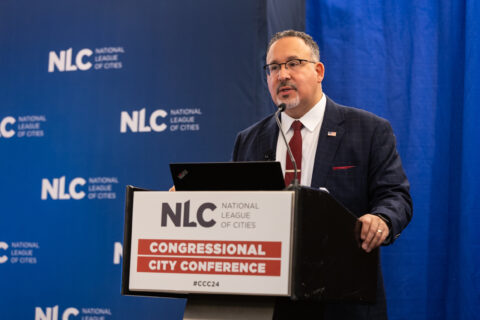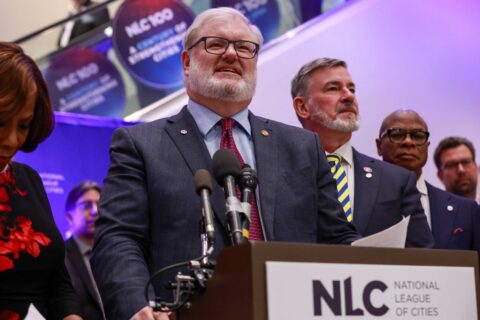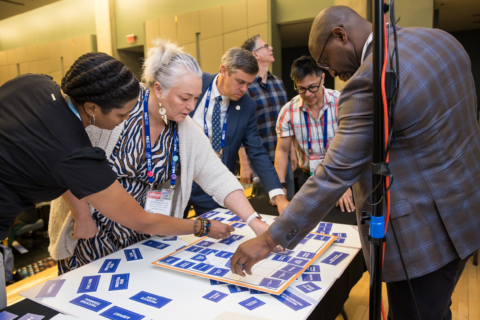As every NLC member knows, local government is unique. Local governments play a more significant factor in the daily lives of Americans than any other level of government. From community development to education to public health, cities administer essential programs that directly affect the lives of a wide spectrum of residents.
What is Low Take-up and Why is it So Damaging to Marginalized Communities?
Take-up is the rate at which eligible residents participate in the benefit programs that were designed for them. As agency heads, program administrators, and elected officials can attest, benefit programs rarely (almost never) reach full capacity.
Too often, elected officials and agency heads put an incredible amount of effort into building great benefits programs only to see low participation rates from residents. It’s like throwing a party that no one comes to.
This has a direct impact on cities, as many federal and state grants are contingent on high participation rates. Even if the need is clear and present, these grants can be pulled out from under cities if not enough eligible residents enroll and participate.
It’s crucial to understand that low participation rates rarely indicate a lack of need or poor program design. Instead, the most common cause is a failure to effectively communicate the right information to the right people in the right manner.
Traditional Outreach Strategies Are Often Ineffective
City governments and elected officials have historically relied on a variety of analog marketing tactics and incentives to increase participation in programs, including ad campaigns, billboards, mailers, door-to-door outreach, and in-person enrollment events. These methods are often costly, ineffective, and can be controversial (such as financial bonuses for participants).
More than that, these tactics rarely reach the people that stand to benefit from the programs the most. Certain outreach methods may be unintentionally reliant on privileges that those in the most need don’t currently have. Some common examples include:
- An in-person enrollment event that may be impossible to attend by a single parent or an individual that has difficulty leaving home.
- Door-to-door outreach which may be ineffective for people who work irregular hours or intimidating and anxiety-inducing to some residents.
- Mailers that are ineffective for those who have unstable housing.
- English-only content, websites, forms, or promotions which are difficult to navigate for non-native speakers.
Unfortunately, many city governments have been slow to reevaluate their efforts. The result is expenditures of financial and staff resources with minimal return on investment, resulting in wasted time and opportunities to help people in need.
But Local Government Has Changed
Forward-thinking city governments have had an eye on digital outreach and online program enrollment for years. Digitizing communications too often faces obstacles, including limited budgets, administrative roadblocks, and a dependence on legacy systems. However, the COVID-19 pandemic forced local governments to modernize the way they connect to citizens and make services available.
During the pandemic, city governments reported a surge of activity on their websites, higher levels of resident engagement through digital channels (like email, SMS, and social media), and a mass migration of in-person activities online. This proved that digital communication is an effective way to reach residents, and local and state governments are trending towards digitization as a result.
More Effective and Equitable Solutions Exist
Digital communications strategies driven by data can be inexpensive, easily scalable, and more effective for improving program participation among high-priority groups than traditional approaches. Below are three strategies that ensure digital program outreach is as effective as possible.
1. Use constituent data to get in front of the right people
Database tools allow elected officials and city governments to pull lists of constituent groups like veterans, small business owners, renters, or low-income populations. Targeting only those who are likely to be eligible for programs keeps costs low and yields key insights into what types of messages are likely to be the most effective for that particular program.
2. Meet people where they are through low-cost, scalable interventions
Your constituents are online and on the phone. Tools like email, SMS (text), and social media allow you to get in front of specific constituent groups in a way that is low-cost, repeatable, and minimally demanding of the recipient’s time.
Research shows that residents are increasingly likely to enroll and participate in a program after multiple touches. It may require a series of 5 or 6 emails or texts to cut through the noise and get a resident to apply for a program. As long as the message is clear, it is perfectly ok to say the same thing over and over again.
3. Intuitive and accessible content ensures that enrollment is as equitable as possible
Provide links to online program applications in your outreach and direct residents to your citizen-centered program sites. Create a single online destination for program information and an “always on” citizen-centric experience where your residents can learn about and apply for program benefits on a single site.
Once they get to the website, make enrollment easy. Make sure sites are accessible by offering multiple language options, using headings to organize the structure of your content, including alt text for images, using colors with strong contrast, and designing forms that support keyboard navigation. From start to finish, do your best to ensure the experience is intuitive by properly labeling your form fields, making navigation between pages clear, and giving your links unique and descriptive names.
Take Action
Use a platform. Constituent Relations Management (CRM) platforms empower elected officials and government departments to reach out, respond, and keep track of their constituents. Through tools for two-way communication and case management, CRMs are one of the best ways to build trust and strengthen relationships between local governments and the people they serve.
Learn More
Join Indigov and former Mayors of Tampa, FL, and St. Petersburg, FL, for an upcoming webinar, “A Guide to Promoting Your Most Important City Initiatives” on April 26th at 2 PM ET to explore strategies for promoting key initiatives, increasing program participation, and leveraging digital tools to connect with constituents.
About the Author
Ian Garner is a Senior Communications Specialist at Indigov.







